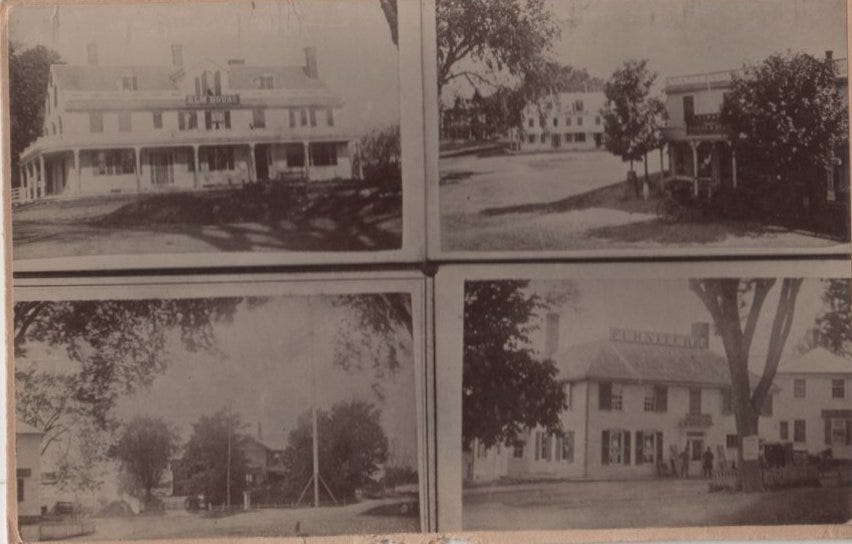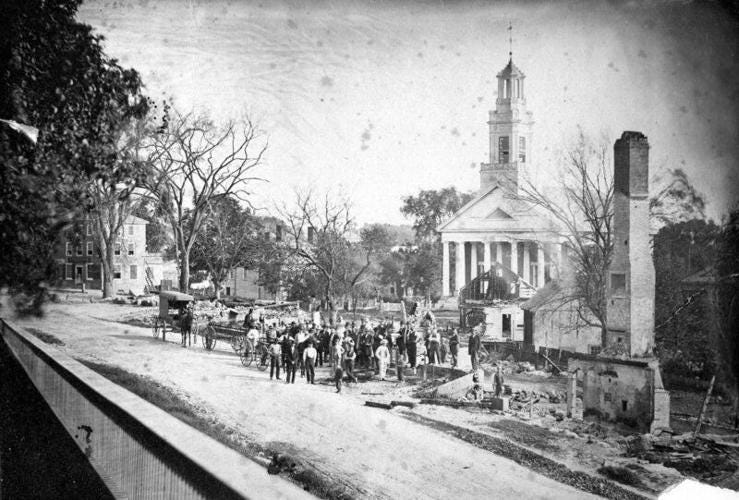From Abbot Furniture to Memorial Hall Library: The Elm Square Fire of 1870
On Sunday, May 29, 1870, fire destroyed an entire block between Pearson Street and Essex Street. Damages were estimated at $15,000 (or $340,000 today). Read on for the rest of the story!
Welcome or welcome back to History Buzz! If you’re a subscriber to the Buzz, thank you! If you’re new here, or you haven’t become a subscriber yet, please sign up for a subscription to have History Buzz delivered directly to your inbox.
On Sunday, May 29, 1870, fire destroyed an entire block between Pearson Street and Essex Street. Although no human lives were lost, the damages were estimated at $15,000 (or $340,000 today). I knew about the Elm Square fire from my long association with the Andover Center for History and Culture. And, Gail Ralston covered it in an Andover Story published in the Andover Townsman newspaper in 2020. I was a tad reluctant to cover it in a History Buzz post.

But I am glad that I decided to do a post on the Elm Square Fire. Long ago, I wrote a newsletter article about the Elm House, which stood on the site of today’s Musgrove Building, diagonally across from the conflagration. During my research into the fire, I learned which block actually got burned. I had been under the impression that the fire happened where Macartney’s … err… Christina’s Bridal Shop is today. The realization that Memorial Hall Library rose from the ashes of the fire, to coin a phrase, led me to appreciate what was there before.

Many suspected that the fire was arson or, to use the language of the time, caused by an “incendiary.” It was discovered at 2:00 in the morning, inside a barn on Main Street owned by the heirs of Amos Abbot. The fire spread to an old house on the same property, occupied by a man named Michael McLaughlin and by Charles Mayer’s harness shop. The buildings and some livestock were consumed. McLaughlin’s furniture and Mayer’s stock and tools were saved.
Moving southward towards Phillips Academy, the fire consumed Eben B. Higgins’ paint shop. Not only did Higgins lose everything, a few of his customers had left items behind to be painted. Those things (a wagon and a few sleighs) were also destroyed. I read that passage and I wondered about the toxicity and chemical composition of 19th century paint. Did it make the fire even worse? What did it feel like to be nearby and breathing in the fumes? In her 2020 article, Gail Ralston noted presence of toxic, volatile substances in the businesses: turpentine, cabinet maker’s glue, and sawdust.
The livery stable of John Cornell was also destroyed. Cornell lost his hay, grain, and three of his sleighs. The townspeople would have been glad to know that all of his horses survived. Two of the equines, “Jerry” and “Jim” were quite popular.
Next, the fire engulfed the buildings owned by Herman Abbot, “on the corner”. Herman’s buildings stood on the site of today’s Memorial Hall Library. Herman used the space for making coffins and framing pictures. Joseph Abbot lived on the premises and sold furniture there.

Before a steam-powered fire engine named Tiger could arrive from Lawrence, the fire nearly destroyed Mrs. Merrill’s house on Essex Street. Only the outside walls were left standing. Tiger arrived just fifty minutes after the alarm reached Lawrence. It seemed to me, for a brief instant, that the firefighters of Andover were doing nothing. We did have a friendly firefighting society after all! I should not have worried. The Andover Advertiser knows how to tell a good story:
“The fire department of Andover, with the Shawshin, Marland, Phillips, Whipple, and Speeder engines put forth their utmost efforts to stay the destruction, but the fire had gained such headway, and was furnished with such combustible materials, that their exertions were comparatively powerless.”
And, the Advertiser has an angle. Further down the page, the paper notes a prevailing feeling that greater fire prevention is needed and the purchase of a steam-powered fire engine is strongly advocated. Ironically, at the time of the fire, Andover’s first steam fire engine was probably being manufactured.
The five fire engines from town that responded were all hand-operated and powered by human muscle. The New Boston, New Hampshire historical society (click here) owns a Hunneman Hand Tub, not unlike the one at the Center For History and Culture, that served New Boston into the 20th century. During a demonstration in 2011,” Constitution #2” managed about 30 pounds per square inch with about two dozen people working the pumps. One source has said that Constitution #2 could throw water up to 200 feet. It would take several teams of men to keep a hand-pumped engine operating. Each team would work 5 minutes on, 10 minutes off. Steam allowed for consistent water pressure. And engines tire less easily than people do.
Andover’s new steam fire engine arrived in late October, 1870. The Advertiser reported that while Tiger “fully sustained its previous popularity.” Andover’s new steam engine performed to everyone’s satisfaction. I was hoping to find statistics and measurements. The crowd that watched the demonstration on the grounds of Smith & Dove got a good soaking.
Reading the Advertiser’s coverage makes me wonder if the paper was an early proponent of urban renewal? The paper opined:
“Several of the buildings, although situated in the heart of the village, were not of great value. It is hoped that they may be replaced by such as will add to the beauty and attractiveness of the place.”
The nerve. Can you imagine reading those words as a victim of the fire?
By September, the town was in negotiations with Herman to buy his lot at Main and Essex Streets. Herman had started laying a foundation for a new building. According to the Advertiser, he abandoned the effort for the sake of securing the erection of the “Memorial Hall” as a public improvement. Herman sold his land to John Smith, of Smith & Dove, for the sum of $3,000. Interestingly, the price asked for in negotiations with the town was $930 more. Small change on a real estate deal in 2022, but a hefty percentage in 1870.
Smith would not have struck a match to start the fire. But, he was a staunch abolitionist who wanted to memorialize Andover soldiers who lost their lives in the Civil War. News of the Elm Square fire reached him in Europe where he was taking an extended rest. In a letter to his son Joseph, sent from Dresden, Smith wrote:
“You mention in your last letter received here that there was nothing yet done with the lots up town where the buildings were burned. the corner lot, where Joseph Abbot’s shop stood, would be a fine place for a Memorial Hall to be built… to keep in remembrance the names of those who gave up their lives in defending our flag and saving my country to God and Liberty.”
John’s granddaughter, Mary Byers Smith, opined that the letter marked the birth of the Memorial Hall Library. In his letter to Joseph, John pledged $25,000 to build a memorial hall and library, provided that the residents of Andover matched the funds. Memorial Hall was formally opened on May 30, 1873.
Something beautiful, Memorial Hall Library rose from the ashes of the Elm Square Fire. We have the efforts of the Smith family, the financial contributions of many townspeople, and the willingness to Herman Abbot to thank for it.
Memorial Hall Library played a formative role in my childhood and, perhaps, my career. Since I started the research on this post, I’ve been asking myself “what if?” What if Herman Abbot finished his new building? What if the fire was less destructive? Downtown Andover would have been quite different.
Thanks for reading!
If you enjoyed today’s post, please sign up for a subscription to have History Buzz delivered directly to your inbox.
Further Reading:
Andover Advertiser June 3 and October 28, 1870 – available on microfilm at Memorial Hall Library (note to the reader, the paper is combined on the same pages with the Lawrence American. Blink and you miss it).
Andover Story: 1870 Fire Brought Disaster to Elm Square by Gail Ralston
https://www.andovertownsman.com/columns/andover-story-1870-fire-brought-disaster-to-elm-square/article_3d569074-edfc-5852-bd6f-aebad2ee83bc.html (Accessed October 3, 2022)
The founding of the Memorial Hall Library, Andover, Mass. by Mary Byers Smith
https://archive.org/details/foundingofmemori00smit (Accessed October 24, 2022)
Also available at Memorial Hall Library and the Andover Center For History and Culture
History Buzz “Sound the alarm” by Marilyn Helmers September 15, 2021
(Accessed October 28, 2022)
Main Street Research Binders compiled by Jim Batchelder -available at the Andover Center For History and Culture
Memorial Hall Library History and Hall Tour
https://www.mhl.org/memorial-hall-library-history-and-hall-tour (Accessed October 24, 2022)
New Boston Historical Society The Fire of 1887 and Historic Firefighting Equipment
http://www.newbostonhistoricalsociety.com/fire.html (Accessed October 24, 2022)







Doug, every interesting article.
I really enjoyed reading it.
Barbara Bunn
Thanks, Doug, for weaving so many threads into this article. I have a much better sense of all that transpired, and how important the Smith family was to Andover and the cause of abolition. More articles in the future, please!